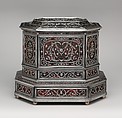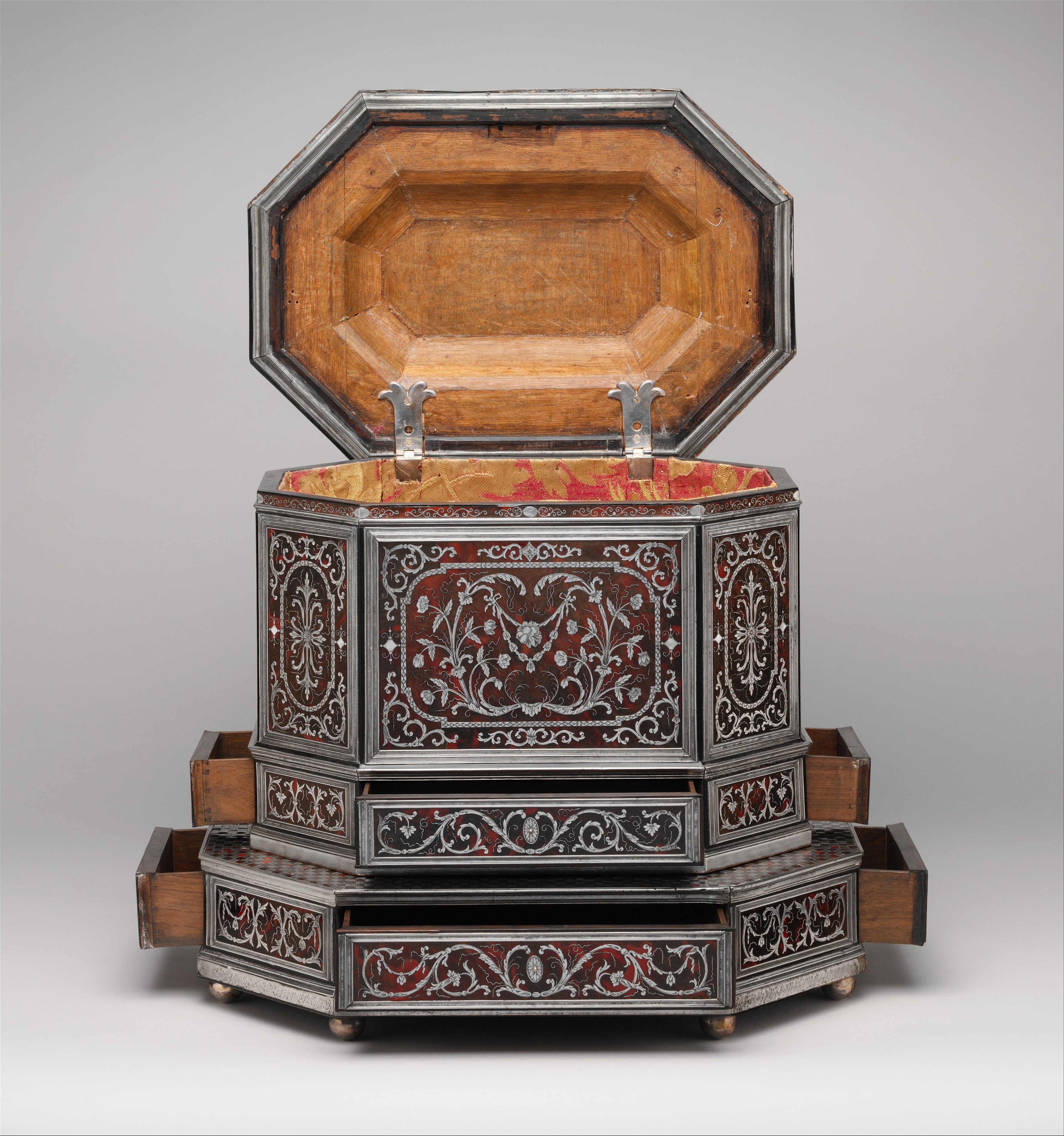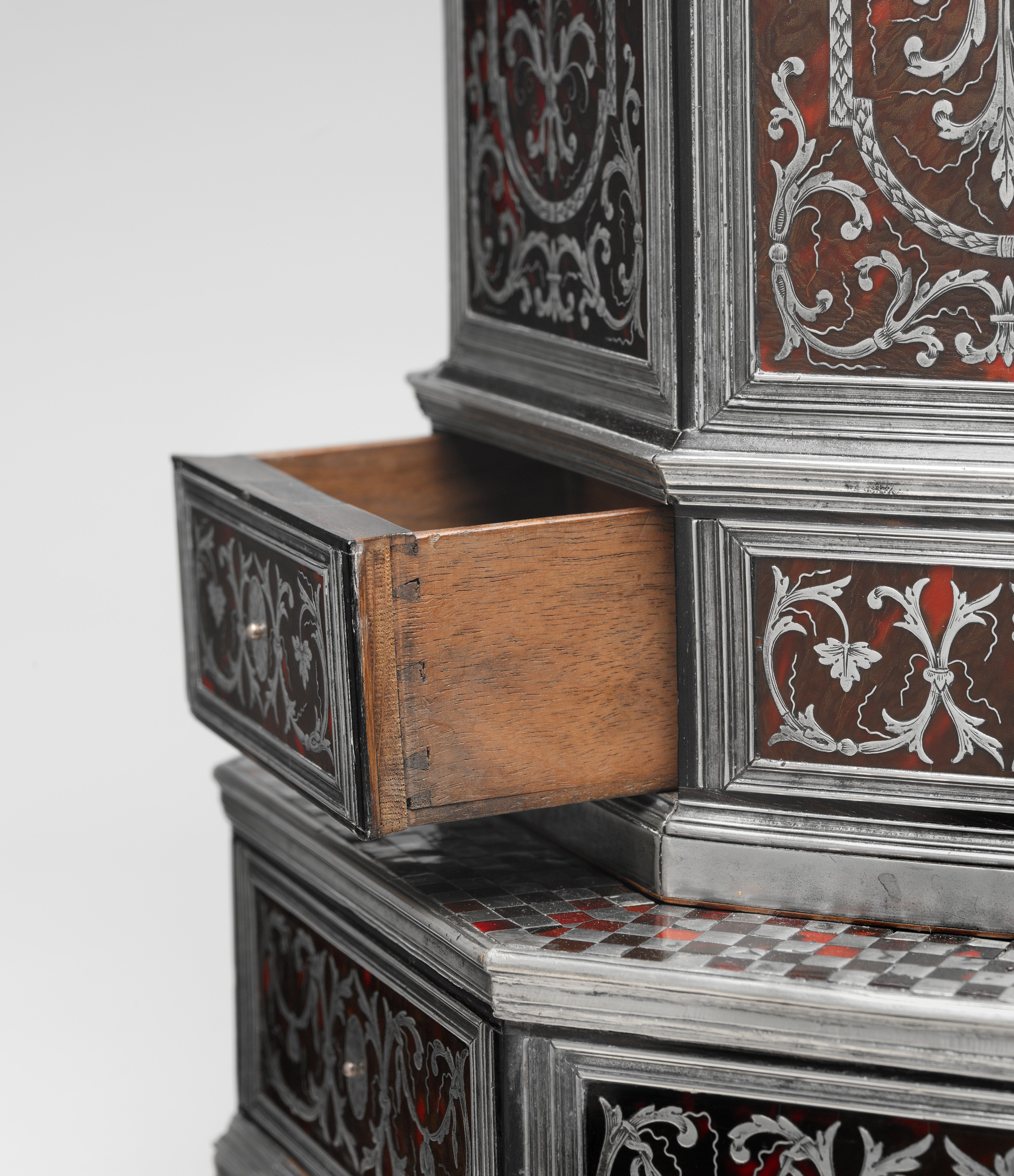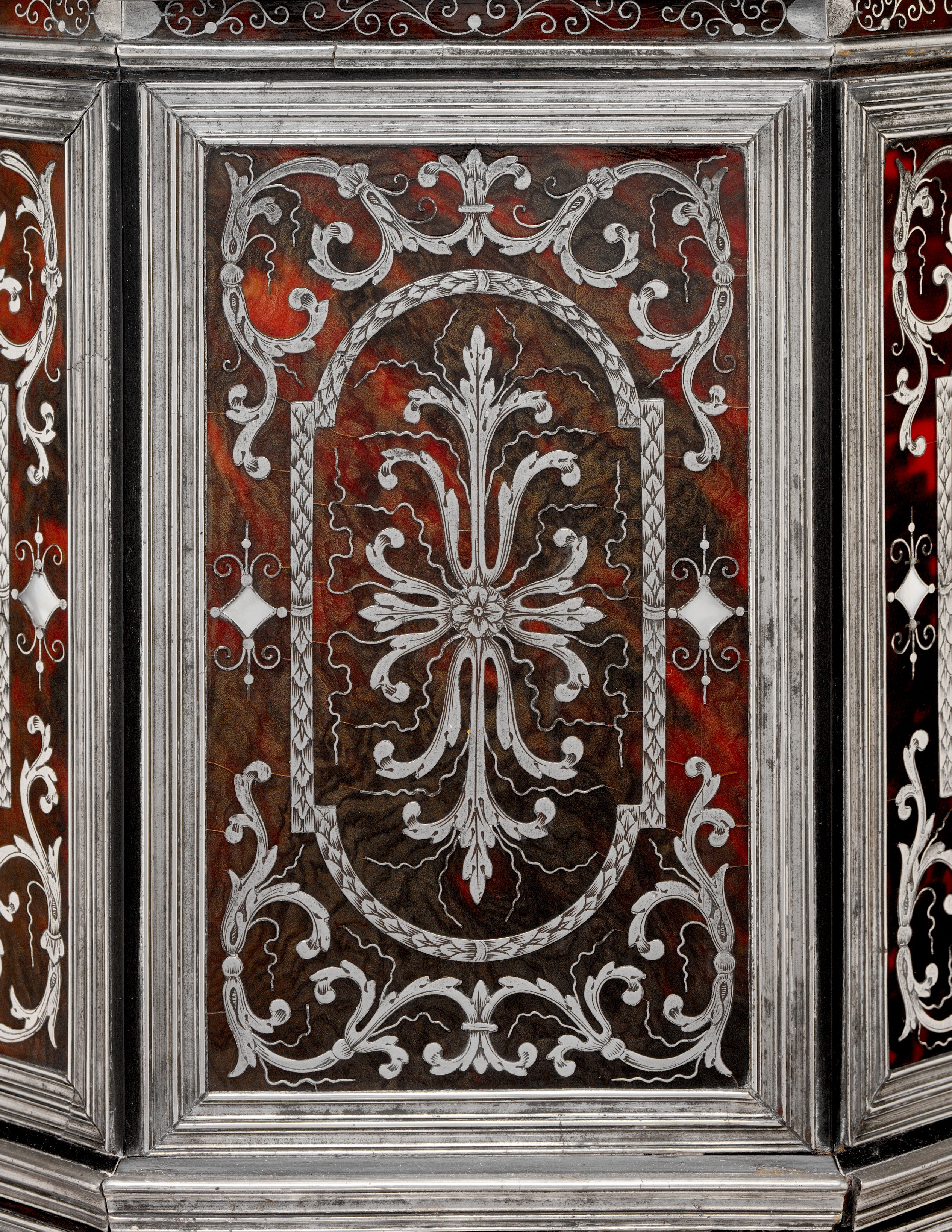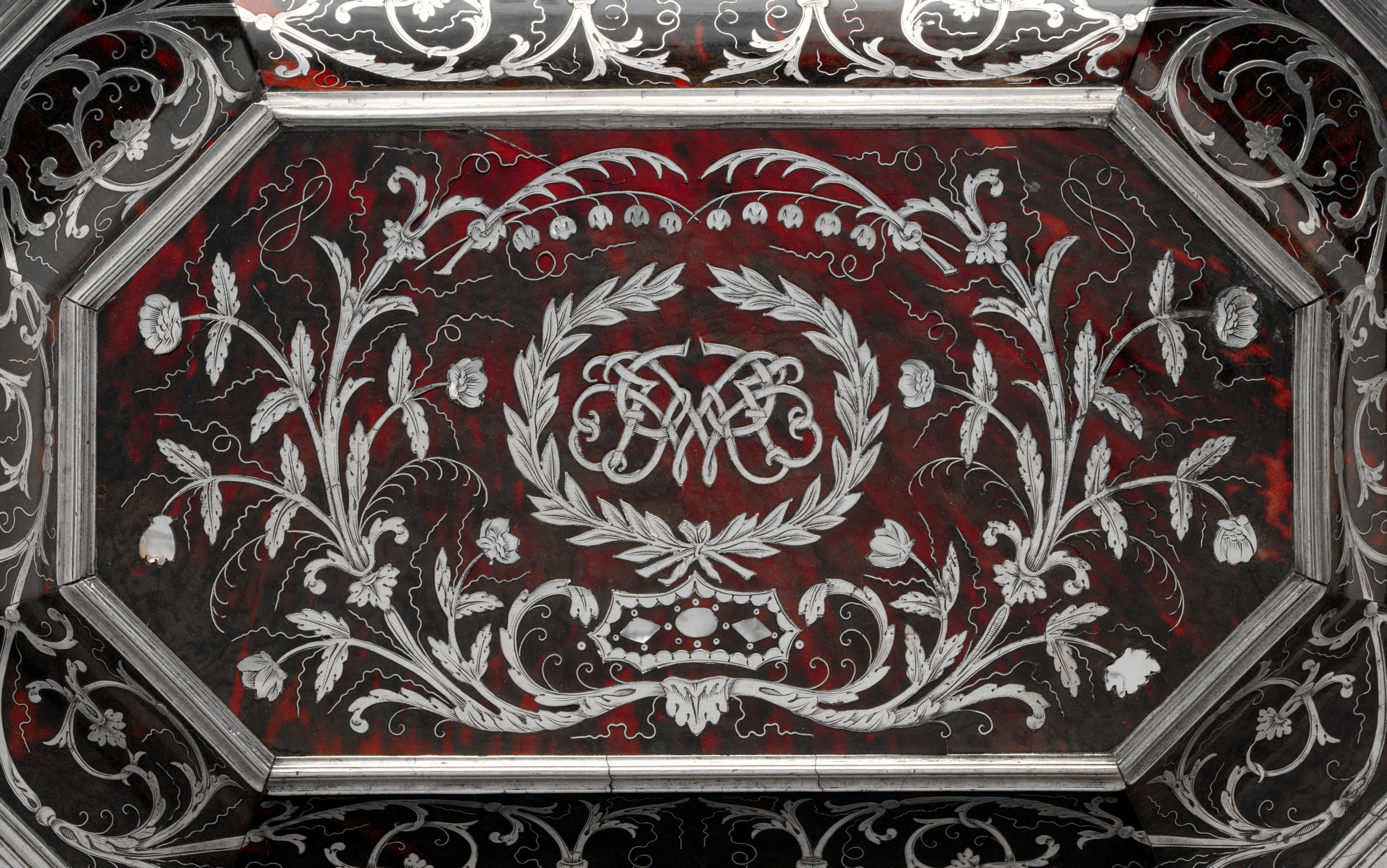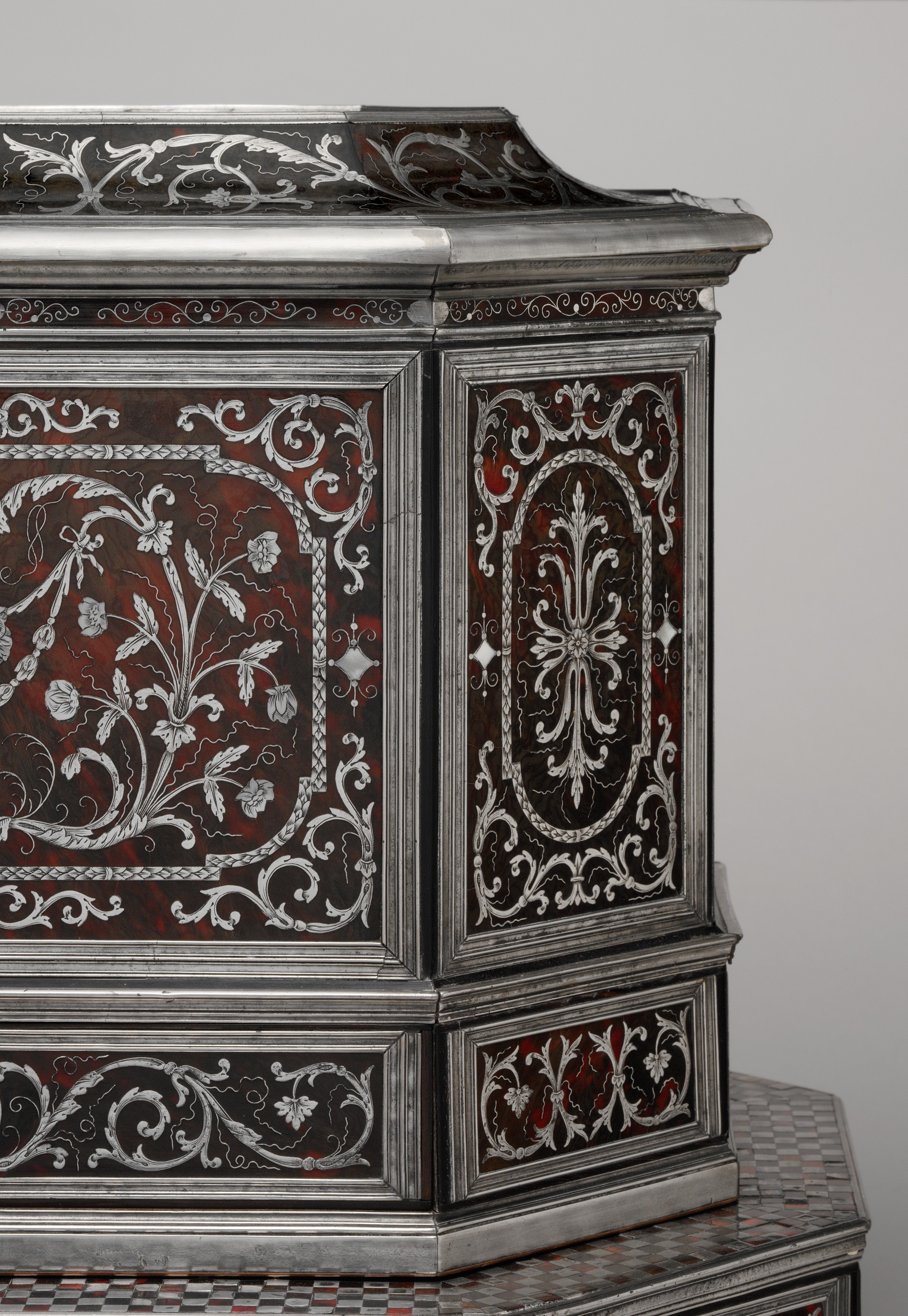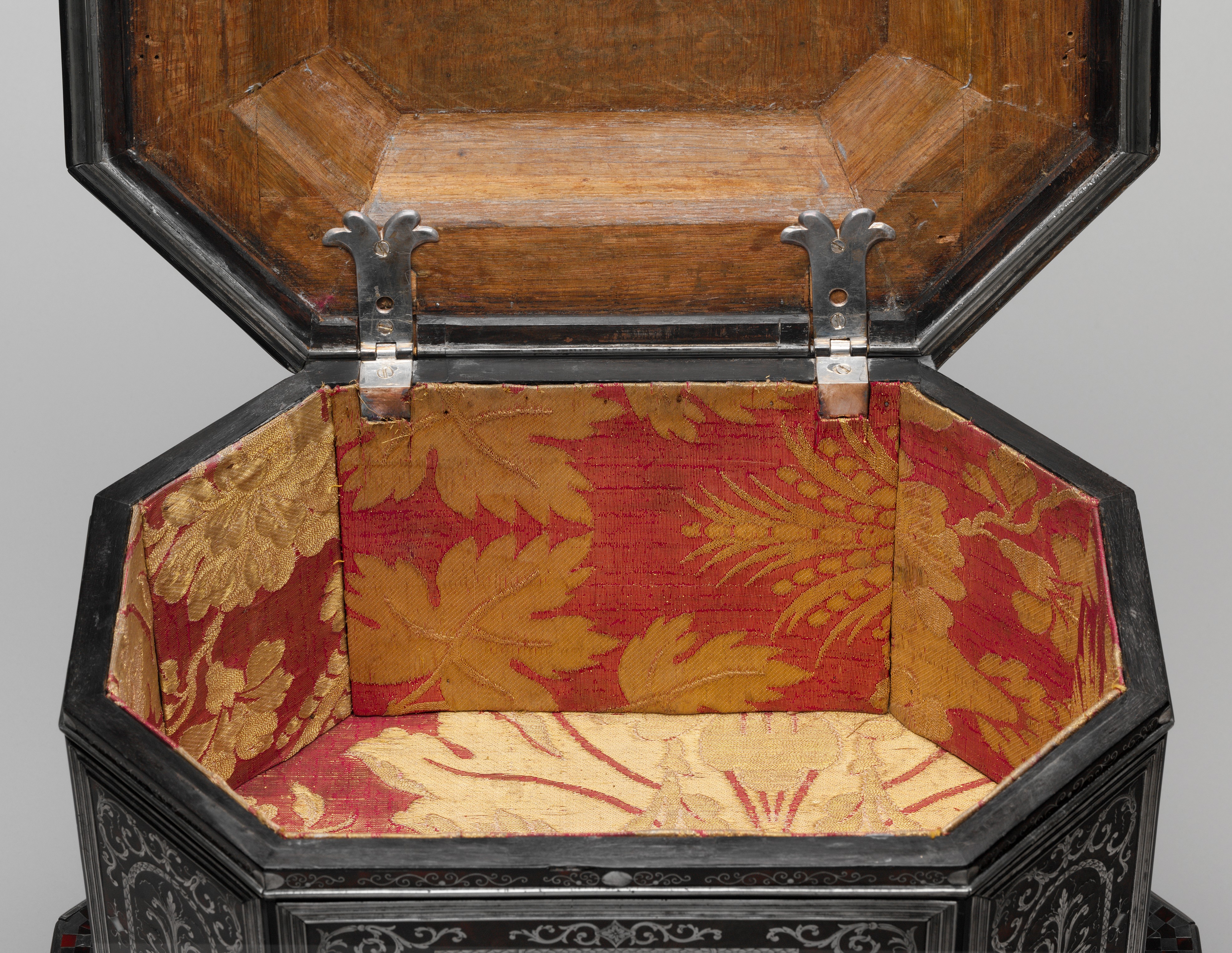Wig cabinet (cabinet de coiffure)
Johann Daniel Sommer II German
This wig cabinet is one of the most elaborate examples of its kind, a work of great refinement and supreme craftsmanship.[1] The exterior is decorated with extremely fine boulle marquetry, which retains many of the original engraved details.[2] Furthermore, it is an early example of the migration of this type of metal-and-tortoiseshell (or horn) marquetry and the High Baroque style in French furniture to the German-speaking cultural areas (see the catalogue entries for acc. nos. 1986.38.1, 1986.365.3). It is obvious that the creator of this cabinet, Johann Daniel Sommer II, occupies a key position in the history of European furniture-making. Unfortunately, the most important facts about his career remain obscure. He was born in 1643 into a dynasty of craftsmen. His grandfather was a carpenter, and his father, Eberhardt Sommer (1610–1677), worked as a carpenter, master builder, and gunmaker in the Franconian town of Künzelsau beginning in 1642. Other members of the family are documented as skillful craftsmen and gifted sculptors.[3] Johann Daniel married in Künzelsau in 1667 and lived there until 1679. Then he sold his properties and moved to an unknown destination. One of his elaborate pieces, a traveling apothecary made for Karl August, margrave of Brandenburg-Kulmbach (1663–1731), contains silver utensils stamped with the Augsburg town mark for 1692–1700. One of these objects, a mortar, is dated 1692. By the late 1600s, however, Augsburg silver, especially sets of toiletry and pharmaceutical items, was esteemed all over Germany; thus, the assumption that Sommer lived in Augsburg must remain speculative. Besides, in Augsburg Sommer could not have used painted horn as a substitute for tortoiseshell as is done in the Museum's piece. The town guaranteed the quality of its luxury goods and ruled that "nobody should be deceived with oxhorn."[4]
It is inconceivable that the Museum's wig cabinet could have been realized without firsthand knowledge of contemporary French designs and marquetry and cabinetmaking techniques. Sommer most likely gained experience in Paris during his journeyman's travels before returning to Künzelsau. In the French capital he may have worked with a man named Jacques Sommer, a supposed relative who is mentioned as a cabinetmaker there until 1669. His widow continued the workshop, receiving a last payment in 1683.[5] He supplied Cardinal Jules Mazarin (1602–1661) and other members of the French court with elaborately decorated sets of furniture that included a mirror, matching table, and two candlestands. Alternatively, Georg Himmelheber has suggested that Johann Daniel Sommer may have worked closely with the French royal cabinetmaker Pierre Gole (ca. 1620–1684); he mentions a table by Gole in the Museum's collection (acc. no. 1986.38.1) as a possible link.[6] By the early 1660s Gole and his workshop were producing intricately inlaid furniture for the royal household of the Sun King. Whether Sommer ever worked with the great French marqueteur André-Charles Boulle (1642–1732) is not known. Boulle, only three months older than Sommer, became a master no earlier than 1666, by which time Sommer must have returned to Germany, for that year he supplied a game board and a dated and signed table to Count Albrecht von Hohenlohe–Langenburg.[7] It seems clear that Boulle and Sommer were influenced by an older master, probably Gole, but why so gifted a cabinetmaker and ornamentist as Sommer returned to his provincial roots instead of becoming a celebrated ébéniste in Paris like so many other German journeymen remains a mystery. The famous tapestry depicting a visit of Louis XIV to the court furniture workshop at Gobelins in 1667 illustrates a red (perhaps tortoiseshell) table with elaborate marquetry thought to be by Gole. It is extremely similar to Sommer's table of 1666 for Count Albrecht. The only noticeable difference is that the table seen in the tapestry has opulent gilt-bronze mounts, whereas Sommer's table has very refined but simpler pewter moldings.[8] The tortoiseshell and metal marquetry applied to both pieces was probably produced by the same technique. Sheets of tortoiseshell and metal were stacked together, a design was laid on the top sheet, and then all the sheets in the stack were cut together. The cutouts could be assembled in master patterns of light material set in a dark ground (première partie) or dark material on a light ground (contre partie).[9] It can be assumed that Sommer introduced this technique to Germany; moreover, the date on Count Albrecht's table suggests that Sommer may have played a major role in the development of this marquetry style in Paris while employed at Gole's workshop. If he was apprenticed as a boy in Germany to his uncle Johann Eberhart Sommer (1614–1693), who made guns richly inlaid with silver or pewter designs, Johann Daniel may have acquired metalworking skills before traveling to Paris.[10] It is not difficult to imagine the nephew transforming his uncle's playful volutes into his own signature zigzags.
The Museum's wig cabinet, with a lid in the style of a Chinese pagoda as an exotic detail, was a portable repository for that essential item of formal masculine attire, the wig. Dressing the hair and adjusting the wig were an important part of a gentleman's morning toilette, or lever,[11] when he was accustomed to receive the most important guests of the day as a special gesture of personal appreciation. As the occasion was public, all the accessories on the dressing table had to reflect the owner's taste and status. The extensive use of polished pewter (presumably in imitation of silver) and the precious silver mounts on this wig cabinet made it impossible that the object should escape the eye of any visitor.[12]
In its form-an elongated octagonal compartment mounted on a stepped base-the wig cabinet is typically South German.[13] When the cabinet appeared on the art market in 1996, it was attributed to Ferdinand Plitzner (1678–1724),[14] who may have studied with Sommer.[15] The key to identifying the patron, to attributing the work firmly to Johann Daniel Sommer, and to dating it at about 1685 are the cipher "JVG" on the cabinet's hinged lid and the stylized rose that appears in the center of several of the marquetry panels. Both refer to Johann Gottfried von Guttenberg (1654–1698), prince-bishop of Würzburg and duke of Franconia. The rose is part of the Guttenberg coat of arms. The use of the prince-bishop's monogram without the Guttenberg arms and the fact that the rose is almost hidden among the other marquetry decorations indicate that Guttenberg considered the wig cabinet a very personal item. Much more elaborately decorated but with almost identical ornamental details is a collector's cabinet, dated 1685, that the prince-bishop purchased from Sommer.[16] This cabinet, which stood in the public rooms of the episcopal palace, shows Johann Gottfried's official cipher as prince-bishop and duke on the central door, under a canopy of lily-of-the-valley sprays that resembles the one crowning the bishop's cipher on the lid of the Museum's wig cabinet. His full coat of arms appears on a carved ivory cartouche that surmounts the pediment over the center of the cabinet's facade. The cabinet can be identified in various inventories of the Guttenberg family and was recently acquired by the Würth Collection in Künzelsau, the town where Johann Daniel Sommer was born and spent much of his life.
Currently no more than twelve objects can be securely attributed to Sommer. The wig cabinet is undoubtedly one of the finest and best-preserved examples, all of which were made during the first vigorous phase of the expansion of luxury furniture-making in Central Europe. Furniture with boulle marquetry (let us call it "Sommer marquetry" in this case, since it was executed long before Boulle gained fame) became very highly regarded in the south German princely courts of the late Baroque period.
[Wolfram Koeppe 2006]
Footnotes:
1. Henry Havard. Dictionnaire de l'ameublement et de la décoration depuis le XVIIIe siècle jusqu'à nos jours. 4 vols. Paris, 1887–90, vol. 4, cols. 1431-50. Based on extensive archival research and his familiarity with personal correspondence of the period, Alain Gruber has determined that many richly embellished boxes with only one large compartment dating from about 1650 to about 1750 were originally intended for the storage of wigs. Frequently decorated with gilded mounts and extravagant inlay, including pietre dure, these boxes are often mistakenly described as jewelry caskets. Dr. Gruber was kind enough to discuss this topic with me in New York on 16 November 2004.
2. The drawer locks may once have had massive silver plates, which were removed and melted down, most likely during the Napoleonic wars. The keyholes were subsequently filled with silver rosettes decorated with engraved lotus leaves; see the conservation report in the archives of the Department of European Sculpture and Decorative Arts, Metropolitan Museum.
3. Elisabeth Grünenwald. "Die Künstlerfamilie Sommer aus Künzelsau." Württembergisch Franken, n.s., 26–27 (1951-52), p. 280; and Stefan Kraut. "Die Familie Sommer im Überblick." In Die Künstlerfamilie Sommer: Neue Beiträge zu Leben und Werk, pp. 35–38. Sigmaringen, 1988, p. 36.
4. Dieter Alfter. Die Geschichte des Augsburger Kabinettschranks. Schwäbische Geschichtsquellen und Forschungen 15. Augsburg, 1986, p. 91.
5. Jules Guiffrey. Comptes des Bâtiments du Roi sous le règne de Louis XVI. 5 vols. Collection de documents inédits sur l'histoire de France, 3rd ser., Archéologie. Paris, 1881-1901, vol. 2, col. 391. See also Florian Knothe. "Les Artisans du Roi: A Family of Craftsmen." Master's thesis, Courtauld Institute of Art, University of London, 2002, pp. 28–36, on Sommer's widow and their daughter Catherine Sommer, who married the cabinetmaker Philippe Poitou (ca. 1640–1709).
6. Georg Himmelheber. "Die Möbel des Johann Daniel Sommer." In Die Künstlerfamilie Sommer: Neue Beiträge zu Leben und Werk, pp. 121–40. Sigmaringen, 1988, pp. 124, fig. 5 (the Museum's piece by Gole), 125, figs. 6, 7 (pieces by Gole inspired by Sommer).
7. Ibid., p. 125.
8. The tapestry is illustrated in Olga Raggio, James Parker, Clare Le Corbeiller, Jessie McNab, Clare Vincent, and Alice M. Zrebiac. "French Decorative Arts during the Reign of Louis XIV, 1654–1715." The Metropolitan Museum of Art Bulletin 46, no. 4 (Spring 1989), pp. 4-5, fig. 5. On p. 52 of Alexandre Pradère. Les ébénistes français de Louis XIV à la Révolution. Paris, 1989. English ed.: French Furniture Makers: The Art of the Ébéniste from Louis XIV to the Revolution. Trans. Perran Wood. London, 1989, there is a detail illustration of the tapestry that includes the table.
9. The technique was being used in Germany for marquetry in wood almost two generations earlier, as a South German buffet dated 1573 and other sixteenth-century pieces from Ulm and Cologne demonstrate; see Wolfram Koeppe. Die Lemmers-Danforth-Sammlung Wetzlar: Europäische Wohnkultur aus Renaissance und Barock. Heidelberg, 1992, pp. 118-20, 120-22, 126-27, nos. M53, M54, M60, color ills. pp. 250, 257.
10. Albrecht Braun. "Zwei Gewehrkolben mit Reliefdekor von Johann Eberhart Sommer." In Die Künstlerfamilie Sommer: Neue Beiträge zu Leben und Werk, pp. 141–50. Sigmaringen, 1988, p. 144, fig. 5.
11. Henry Havard. Dictionnaire de l'ameublement et de la décoration depuis le XVIIIe siècle jusqu'à nos jours. 4 vols. Paris, 1887–90, vol. 4, cols. 1431-50; and Peter Thornton. Seventeenth-Century Interior Decoration in England, France and Holland. Studies in British Art. New Haven and London, 1990, pp. 230-33.
12. On the special pewter alloy used in the marquetry, see the condition report on the wig cabinet dated 30 September 2004 in the archives of the Department of European Sculpture and Decorative Arts.
13. Wolfram Koeppe. Die Lemmers-Danforth-Sammlung Wetzlar: Europäische Wohnkultur aus Renaissance und Barock. Heidelberg, 1992, p. 206, no. M107, color ill. p. 250, and p. 242, M142, color ill. p. 257.
14. Catalogue of a sale at Sotheby's, New York, 12 January 1996, lot 1044 (described as South German). See also Medieval and Renaissance Sculpture and Works of Art. Exh. cat., Blumka Gallery. New York, 1997 (in which the cabinet is attributed to Ferdinand Plitzner). The object was acquired by a Los Angeles private collector who subsequently lent it to the Los Angeles County Museum of Art until 2004, when it was acquired by the Metropolitan.
15. On Plitzner's connections with Sommer, see Heinrich Kreisel. Die Kunst des deutschen Möbels: Möbel und Vertäfelungen des deutschn Sprachraums von den Anfängen bis zum Jugendstil. Vol. 2, Spätbarock und Rokoko. 2nd ed. Rev. by Georg Himmelheber. Munich, 1983, pp. 82-90; Wolfram Koeppe. "Möbel und Schaustücke." In Liselotte von der Pfalz: Madame am Hofe des Sonnenkönigs, ed. Sigrun Paas, pp. 179–88. Exh. cat., Heidelberger Schloss. Heidelberg, 1996, p. 184, no. 276; and Wolfgang Loescher. "Ein 'Boulle'-Möbel von Ferdinand Plitzner: Zuschreibung mit Hilfe von Konstrucktions- und Boulle-Technik-Details." Restauro, November–December 1997, pp. 454–59.
16. Ursula Angelmaier, Ulli Freyer, and Andreas Huber. Der Kabinettschrank des Würzburger Fürstbischofs Johann Gottfried von Guttenberg von Johann Daniel Sommer. Künzelsau, 2004.
Due to rights restrictions, this image cannot be enlarged, viewed at full screen, or downloaded.
This artwork is meant to be viewed from right to left. Scroll left to view more.
